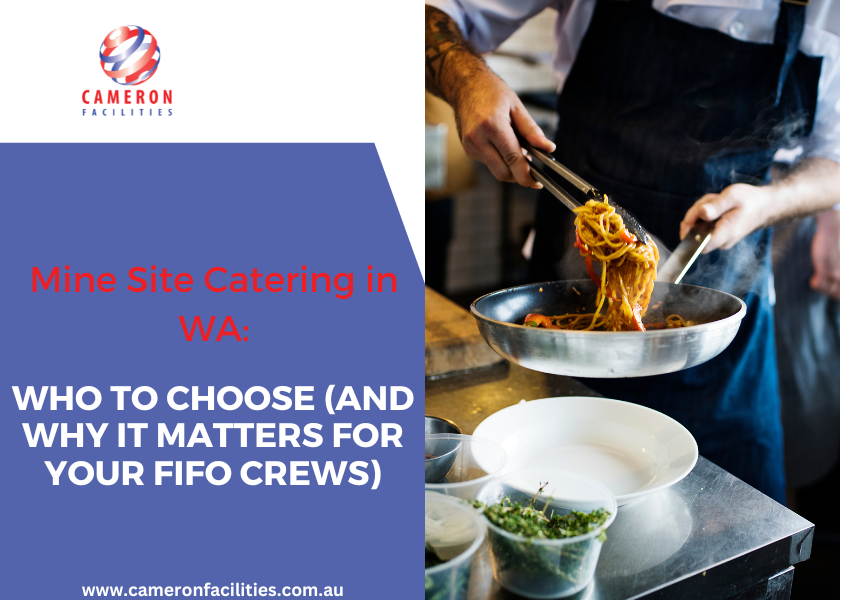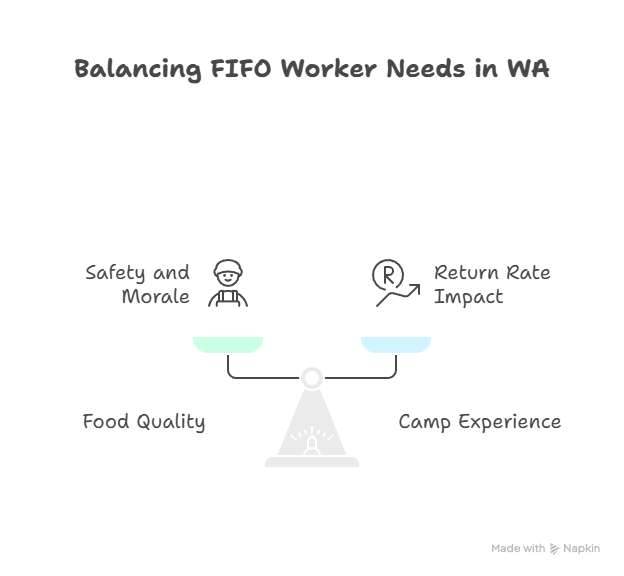
“If the food slips and rooms feel tired, word spreads fast on site.” That line gets nods in every pre-start I visit. In WA, the food and camp experience are not “nice to have.” They affect safety, morale, and whether people come back next swing.
So, which mine site catering companies in Western Australia are worth shortlisting? Let’s compare the main players, the pricing reality, and the factors that keep FIFO teams healthy and productive.
Two quick facts to set the scene:
- WA’s FIFO Code of Practice links camp design and services, including meals, to worker wellbeing and safety. (See the FIFO Code of Practice.)
- WA worker groups say food standards matter. In one submission, 98% of respondents wanted minimum standards for food quality, quantity, and dining facilities. (See the camp standards survey.)
What “good” looks like in WA (a checklist you can copy)
“Give us consistent, hot meals at 1 am change-out. That’s it.” That’s how one Ops Manager put it. Here’s a quick checklist to measure vendors against:
- WA footprint & surge capacity: Can they cover Pilbara/Goldfields and swing up extra heads fast?
- Safety & QA: Clear HACCP/ISO processes, temp logs, allergen controls, and site audits.
- Nutrition for FIFO: Balanced menus, night-shift hotlines, grab‑and‑go, and hydration points.
- Indigenous participation: Real partnerships and reporting, not just targets. (See the WA Aboriginal Procurement Policy update: policy overview. Find verified suppliers via Supply Nation and the Aboriginal Business Directory WA.)
- Environmental basics: Waste, water, and energy practices that fit site constraints.
- Transparent pricing: Clear PPPD (per person per day) inclusions, pass‑throughs, and escalation rules.
Shortlist comparison: major WA players
Below are established providers that many WA miners consider. Best fit depends on your camp size, location, and whether you need integrated village services.
“The brand is less important than proof they can mobilise, flex, and keep our people fed well, week after week.”
ESS (Compass Group)
- Best for: Large camps that want one provider for catering, cleaning, and support services.
- WA footprint: National remote-site leader with a strong presence in mining villages. (See ESS Support Services.)
- Indigenous & local: Programs at both national and local levels; ask for WA-specific reporting.
- Strengths: Scale, integrated services, consistent standards.
Watch-outs: Big-machine processes ensure site-level KPIs and feedback loops.
Sodexo
- Best for: Integrated village services across large portfolios.
- WA footprint: Long-running Pilbara relationship with Rio Tinto villages. (See the Sodexo–Rio Tinto contract and Rio’s story on serving “millions of meals”.)
- Indigenous & local: Mix of partnerships and programs; ask for proof of impact at the site level.
- Strengths: Depth in IFM, logistics, and systems.
Watch-outs: Media has flagged quality concerns in parts of Australia, use tight KPIs and site audits. (See recent coverage.)
Civeo
- Best for: Villages where the operator both owns/operates accommodation and runs catering.
- WA footprint: Operating 11 villages under a six‑year extension from 1 Jan 2025. (See the WA contract extension and their village properties.) Earlier, Civeo also acquired Action Industrial Catering to deepen WA capability. (See the acquisition note.)
- Indigenous & local: Request site-level partnerships and a clear reporting cadence.
- Strengths: End‑to‑end village model, clear scope control.
Watch-outs: Align commercials when the operator is also the landlord.
Cater Care
- Best for: Mid- to large camps seeking an Australian provider with flexible menus.
- WA footprint: Active in remote mining and oil & gas. (See Cater Care – Remote Mining.)
- Indigenous & local: Often tailored by site; verify Supply Nation engagement.
- Strengths: Flexibility, on‑the‑ground focus.
Watch-outs: Ensure surge capacity and relief planning.
Cameron Facilities
- Best for: Mining camp management, exploration fly‑camps, and rapid mobilisations.
- WA footprint: Building maintenance, facility management, catering, remote camps, and site management. (See Australian Camp Services.)
- Indigenous & local: Open for partnership.
- Strengths: Speed and flexibility.
Watch-outs: Match scope to growth, and agree on how they scale with you.
Snapshot matrix
| Vendor | Best for | WA footprint evidence | Indigenous engagement | Notes |
| ESS | Large integrated camps | ESS Support Services | Program-based; ask WA proofs | Strong systems; align KPIs |
| Sodexo | Multi‑village portfolios | Sodexo–Rio Tinto, Rio story | Mix of models | Tight QA; audit often |
| Civeo | Owned/operated villages | Contract extension, Properties, AIC deal | Site‑level reporting | Align commercial structure |
| Cater Care | Mid‑large camps | Cater Care Remote | Verify with supplier lists | Confirm surge plans |
| Cameron Facilities | Integrated facilities management | Cameron Facilities | Open for partnership | Fully integrated facility management |
Pricing reality in 2025: how quotes actually work
“The cheapest rate loses its shine the first time you need 50 extra heads next swing.” Price chips away in hidden spots, so make these items crystal clear:
- PPPD rate (per person per day): What exactly is included? Menu cycle length? Snacks? Night-shift hotline?
- Pass‑throughs: Travel, utilities, freight, and remote allowances—how are they billed?
- Mobilisation & demobilisation: Kitchen setup, freight, temporary power/water, and clean-down.
- Scope creep controls: How do changes get approved and priced?
- Relief & surge: What’s the cost and lead time for extra heads?
When a provider also runs the village, services can be bundled. That can be efficient—if the scope and KPIs are tight. (Compare integrated models at ESS Support Services and Civeo village properties.)
Food, well-being, and retention: what the research says
Good food and decent facilities help people feel safe and supported. WA guidance and studies point in the same direction:
- The FIFO Code of Practice sets out how camp design and services can reduce risk. (See the code.)
- A WA submission found 98% support for minimum food and facility standards. (See the survey.)
- A literature review links FIFO work conditions to mental health and well-being outcomes. (Read the review.)
Practical menu tips: Rotate nutrition‑balanced menus, keep night‑shift hot, stock grab‑and‑go, label allergens, and keep hydration points close to high‑heat work.
Indigenous procurement: do it well, not just to hit a number
“If a vendor can’t show Indigenous impact beyond targets, they’re not getting to round two.” Strong tenders in WA do three things:
- Set weighted criteria for Indigenous participation and local content, with clear deliverables and quarterly reporting. (See WA’s Aboriginal Procurement Policy.)
- Source verified partners early using Supply Nation and the Aboriginal Business Directory WA.
- Show working models—like big miners who partner with service providers and Aboriginal businesses under long‑term frameworks. (See this FMG–Sodexo contract model summary: innovative model and Fortescue’s engagement programs.)
Your shortlist action plan (use this to move fast)
- Scope the need: Camp size, shifts, menu must‑haves, and integrated services.
- Build a longlist: Start with the vendors above; add region‑specific players if needed.
- Run an RFP with a site visit: Score against food quality, safety, surge, Indigenous impact, and price transparency.
- Pilot & set KPIs: 30‑day menu pilot, nightly QA checks, and weekly crew feedback.
- Review at 90 days: Lock in the cycle, adjust headcount rules, and publish a simple dashboard.
Want help? Book a 15‑minute discovery call or ask for our free Camp Catering RFP Template and Camp Audit Checklist.
Conclusion
The “right” mine site catering partner in WA depends on four things: a real WA footprint, tight safety and QA, Indigenous impact you can prove, and the ability to keep people fed well across long rosters. Use the checklist, compare the shortlists, and make the numbers and the people work.






